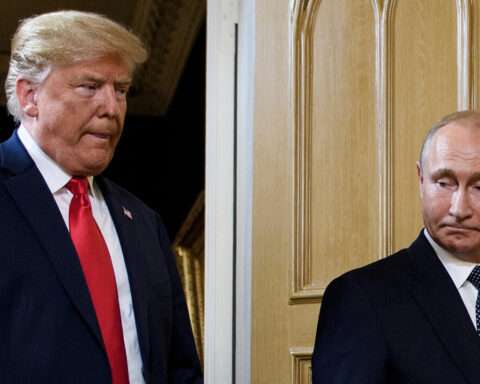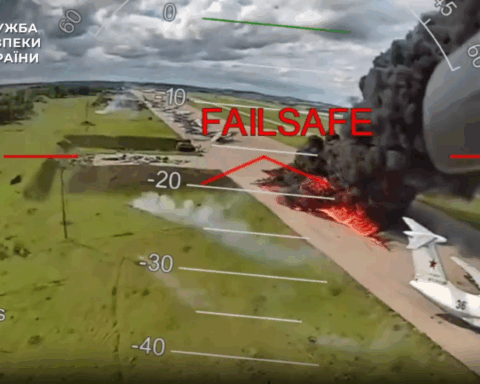LYMAN, Ukraine — Sweeping low along a river near the eastern Ukrainian town of Lyman, a military helicopter flew east toward Russia past the gleaming spire of an Orthodox church. In the bright morning light, the yellow and blue Ukrainian flag on its nose cone was unmistakable.
Just a week earlier, such a sight would be unimaginable. At that time, elite Russian forces were entrenched in Lyman, a strategic rail hub that served as a launching pad for Russian assaults on the major Donetsk region cities of Slovyansk and Kramatorsk.
Many of those soldiers are now lying in Ukrainian morgues, after an encirclement by Ukrainian forces and, later, the retreat of the surviving Russian troops — one of the main achievements of a counteroffensive in recent weeks in the Kharkiv and Donetsk regions.

The retreating Russians left enormous quantities of ammunition and supplies in their wake, Ukrainian soldiers told RFE/RL.
“Everything was done beautifully and precisely,” said Oleksandr, a 30-year-old soldier sitting in a Ukrainian Army SUV on the main square in Lyman earlier this week.
In a humiliating defeat for Moscow, the Russian Defense Ministry announced on October 1 that it was withdrawing its forces from Lyman, three months after they seized control of the town. One day earlier, at a televised Kremlin ceremony, President Vladimir Putin signed documents that Moscow baselessly claims mean Donetsk and three other partially occupied regions of Ukraine now belong to Russia.
Russian positions in the town were first compromised when Ukraine launched its sweeping counteroffensive in the adjacent Kharkiv region, north of the Donetsk region, in early September. The push, which liberated over 3,000 square kilometers, served to cut off northern supply lines for the Russian troops in Lyman. Ukrainian forces then pushed forward to the villages surrounding Lyman, encircling the town on three sides and pounding exit routes with artillery.

Soldiers interviewed by RFE/RL pointed toward NATO weapons as being key to victory.
Oleksandr and Dima, a 25-year-old fellow soldier who works to correct artillery fire, both said that artillery provided by NATO nations was devastating to Russians attempting to flee.
“Their losses were large,” Oleksandr said, because Russian troops moving into and out of Lyman traveled in large columns that were highly vulnerable to precise artillery strikes. By contrast, he added, Ukrainian losses were “piecemeal cases.”
The soldiers did not want their last names published, citing security concerns.
According to Oleksandr, Russian soldiers began their escape only after Ukraine destroyed a relief column along the road to Drobysheve, northwest of Lyman, one of the main roads back to Russian lines.
Signs Of Panic
The Russians started their escape far too late, though. By the time they began, all roads out of the city had been cut off except one to the northeast, to the village of Torske. This road, though, was covered by Ukrainian artillery, according to the Institute for the Study of War (ISW), a U.S.-based conflict research group.
Panic appears to have set in among the units, which included elite formations such as the 144th Motorized Rifle Division and 752nd Motorized Rifle Regiment of the 20th Combined Arms Army.
“We’d take off, and they’d have already run away,” said Dima, the artillery spotter, referring to the drones his unit uses to correct cannon fire.
The evidence of these strikes littered one forest road into Lyman, on which a column of seven vehicles lay scorched in a straight line. On the ground lay hundreds of AK-47 bullets that had spilled from a destroyed ammunition truck, as well as mounds of supplies such as uniforms, medical dressings, and deodorant.
While it’s unclear how many troops Russia may have lost, Serhiy Hayday, the top Ukrainian official in the neighboring Luhansk region, said that more than 5,000 Russian soldiers were in the town on the day Russia withdrew its troops.
!['Their Losses Were Large': In Liberated Lyman, Ukrainian Soldiers Recall Russian Retreat 11 Graffiti left by Russian soldiers at a bus stop in Lyman. Besides the names of the Russian cities Tver and Perm, one of the words says "'Please forgive [us]."](https://gdb.rferl.org/04020000-0aff-0242-b239-08daada5a2d8_w650_r0_s.jpg)
On the next day, October 2, President Volodymyr Zelenskiy said that Ukrainian forces were in full control of Lyman.
Analysis by the ISW suggested that yet another factor may have played into the rout: After heavy losses among elite units in the weeks after Putin launched the invasion on February 24, many of the remaining units have been unable to fight effectively.
‘Russian Lend Lease’
The Russian soldiers were not poorly supplied, according to Oleksandr and Dima, who pointed out abandoned Russian body armor with a manufacturer date of 2022. Vasyl, a soldier at a checkpoint leading into Lyman, mockingly referred to the masses of captured ammunition captured as “Russian lend lease” — a play on the name of a U.S. program for supplying weapons to Ukraine.
The combination of weapons from NATO countries and captured or abandoned Russian weapons makes a marked contrast to the early days after the Russian invasion, the soldiers said.
“We’d have one packet of Grad rockets for the day,” Oleksandr said of the first month of fighting. “Five wouldn’t work, and three would zig-zag off somewhere.”
But cutting-edge Western weaponry and training is hardly the rule among Ukrainian military units.

At the checkpoint, Vasyl and Ihor, who are members of Ukraine’s territorial defense force, basked in the unusual warmth of an October morning. The territorial defense forces are a reserve unit with minimal training, with many joining these units in the first days of the war.
Vasyl said he and his unit had fought for two months near Kyiv at the start of the invasion, then had a month of training, and then four months at the front. The unit hasn’t been rotated out once since the Russian invasion.
Their training and command structure is minimal, Vasyl said, pointing at a soldier with prior military experience as a voice of wisdom. When asked whether or not his unit was empowered to make decisions, a claim sometimes touted in the West to explain Ukraine’s successes on the battlefield, Vasyl shrugged and smirked. “A certain amount of decentralization exists,” he said.
Sitting on the ground cleaning the unit’s PK machine gun, a standby of the Soviet Army first introduced in 1961, Ihor described the Soviet-era weapons its members are using with an expletive.
While they had plenty of food and ammunition, he and Vasyl said, they each had a single uniform and one pair of boots, and not all of the soldiers had received winter clothing.
Still, after weeks of Ukrainian advances, the soldiers were upbeat and confident. When asked about Putin’s recent mobilization order, which could throw hundreds of thousands of new Russian troops into the war, Vasyl said that just meant “more targets.”






